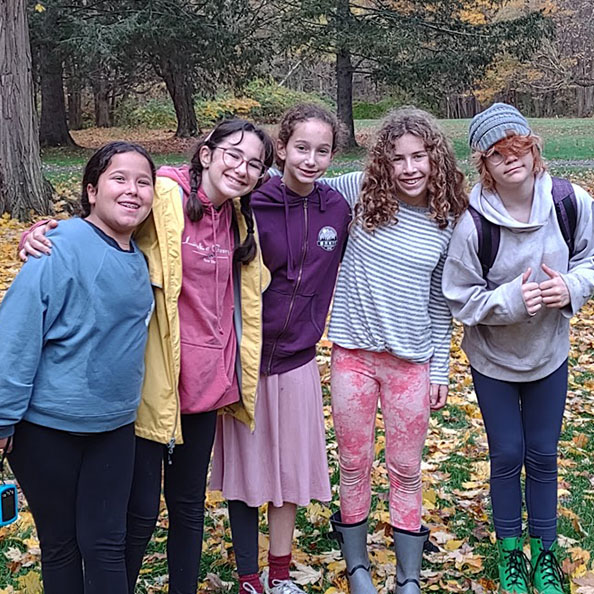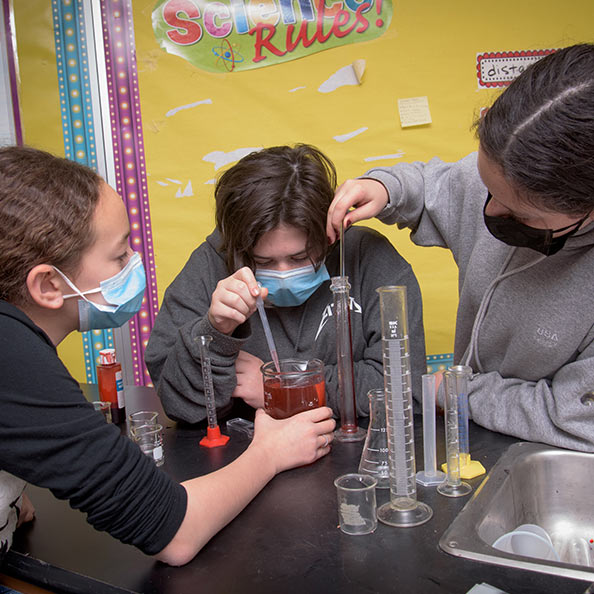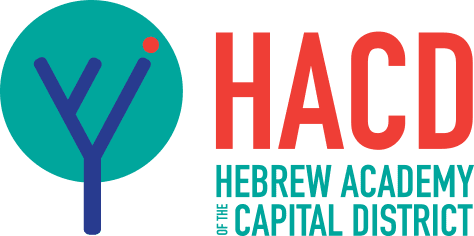Academics
Middle School (Grades 6 – 8)
Summary
The stimulating curriculum recognizes that middle school is a transformative time of intellectual, emotional, and spiritual development. Over the course of their Middle School years, students encounter a myriad of authentic learning and leadership opportunities with a consistent focus on higher-level thinking and analytical skills throughout each subject and discipline. Small class sizes provide students with the opportunity to form strong bonds with their teachers and allow teachers to challenge each student at his or her own pace. By completing the middle school curriculum, students have the opportunity to acquire up to four high school credits and complete the regents exams in Algebra and Living Sciences, as well as completing the proficiency exams in Hebrew language and Spanish 1, enabling them to enter high school with advanced standing.
We care about the social-emotional growth of early adolescents just as much as academics. Our teachers don’t just teach History or Science or Jewish Studies; they teach Middle School students. Here are just a few examples of our distinctive program:
- Positioning students as members of the global community through integrated General, Judaic, and values-based curricula.
- Encouraging strong and collaborative student-teacher relationships with our small classes.
- Supporting passions for athletics. We are proud to offer 5 sports competing in the Capital District Friendship League with other local independent schools.
- Exploring civil and human rights through our annual participation in the OU’s Teach NYS, which takes us to the Capitol to advocate for equitable government funding for nonpublic schools.
- Participating in Better Together sponsored by the Legacy Heritage Foundation, a program connecting our middle school students and seniors in a meaningful way which inspires our teens to express their Jewish identity while offering seniors a sense of relevance.
- Competing in Future City, a project-based national learning program where students in 6th, 7th, and 8th grades imagine, research, design, and build cities of the future by STEAM skills while dreaming about the future to create a city of the future.
- Donating through Kids Can Build, an exciting competition run by the Shalom Food Pantry in the Capital Region. This program educates children to give back to their community and brings awareness to food insecurity.Students from local middle schools compete by building life-size structures out of donated food items.
Middle School: Grades 6-7
GENERAL STUDIES
English & Language Arts
The ELA curriculum in the sixth and seventh grades is a two-year program which is linked to the social studies curriculum where appropriate. Students take part in the Reading and Writing Workshop format for ELA. Students complete four units of study each year, including opinion, informational, persuasive, and narrative writing. Students also write short stories and complete public speaking components. During the two years, students read a variety of articles, short stories, poems, and myths. Some literature is examined by the entire group, including works such as The Giver, The Lightning Thief, Tuck Everlasting, and Alexander Hamilton: An Outsider. Students also engage in independent reading by completing four novels during the school year, reflecting on what was read, and completing a project of their choice. Critical thinking and literature interpretation skills are developed throughout the school year, as well as grammar instruction, outlining texts, and close readings.
Mathematics
Math 6
The Math 6 program builds new mathematical knowledge through problem solving, collecting and organizing data, connecting mathematical ideas to the real world, and using basic algebra. Expanding on the sixth grade New York State Common Core standards, it includes work with integers and rational numbers; ratios, proportions, and percents; writing and interpreting expressions; equations and inequalities; geometry; and statistical analysis and probability.
Math 7
Students in the Math 7 program will expand their mathematical knowledge while being challenged to surpass the New York State Common Core standards for mathematics. Students will increase experience and proficiency with integers and rational numbers. Through real-world application problem-solving, students utilize expressions and equations, inequalities, ratios, proportions, and percents. The geometry component focuses on constructions and scale drawings, circles, area, surface area, and volume. The probability and statistics unit includes sampling and comparing populations.
Math 7 Accelerated
Students in the Math 7 Accelerated program complete the Math 7 and Math 8 curricula in one school year, preparing them to take Algebra I in the eighth grade.
Science
Students study Physical Science and Life Science in a two-year rotation.
Physical Science
The Physical Science course serves as a foundation for other high school courses, especially chemistry and physics. Physics units include: motion, forces, work and power, momentum, energy, electricity and magnetism, and wave phenomena. Chemistry units include composition and classification of matter, atomic structure, and the periodic table, focusing on chemical symbols, patterns, trends and isotopes, chemical bonding, compound naming, and chemical reactions. Our work is in alignment with the Core Curriculum Standards for Intermediate Science, as well as the NYS Science Learning Standards for middle school.
Life Science
The Life Science course serves as a foundation for other high school courses, especially biology. The course units include cell structure and function, cell processes and energy, introductory genetics, modern genetics, ecology, classification, change over time, the microbial world, the plant kingdom, the animal kingdom, and the human body. Our work is in alignment with the Core Curriculum Standards for Intermediate Science, as well as the NYS Science Learning Standards for middle school.
Social Studies
The Social Studies curriculum in the sixth and seventh grades is a two-year program which follows the NYS guidelines and enhances students’ study of Jewish History. In year one (World History) students study geography and the early world civilizations such as ancient Greece, the Mongols, and ancient Egypt. They examine artifacts and analyze primary source documents and texts related to World History. In year two (American History through 1865) students study the geography of the United States, the Meso American and Native American civilizations, and the exploration, settlement, and creation of governments for the American Colonies. The year concludes with our study of the Civil War.
Spanish
Spanish 6
This is the first of three years of study that prepares students to take the Checkpoint A examination in Spanish. In this first year, students are introduced to the Spanish language. Students develop vocabulary, study present tense verb forms, and build basic conversational skills. Students read brief passages in Spanish and write short responses. The class also focuses on the cultures and traditions of Spanish speaking countries.
Spanish 7
Students continue their study of Spanish by expanding their vocabularies and their conversational skills, and by mastering more complex grammatical forms. Longer passages are read, and students write essays up to one page in length. Students are encouraged to express themselves in Spanish through projects and presentations to the class.

Middle School: Grade 8
GENERAL STUDIES
English & Language Arts
The ELA curriculum for the eighth grade enables students to continue to develop and enrich their critical thinking, reading, and writing skills through the Reading and Writing Workshop format. Students complete four units of study each year, including opinion, informational, persuasive, and narrative writing. Students also write short stories and complete a public speaking component. Further instruction on paragraph and essay organization is provided. Students apply their writing skills to standards for social studies, such as thematic and DBQ (Document-Based Question) essays. Works studied by the class frequently include To Kill a Mockingbird, The Chosen, and Romeo and Juliet. Students also engage in independent reading by completing four novels during the school year, reflecting on what was read, and completing a project of their choice. Critical thinking and literature interpretation skills are developed throughout the school year, and are supported by grammar instruction, outlining of texts, and use of close reading.
Mathematics
Math 8
Students in the Math 8 program, through increased problem solving and more abstract reasoning, are being prepared for the High School math sequence. Consistent with Common Core standards, the focus is on solving more complex linear equations and systems of equations, understanding notation and the concept of functions, and analyzing 2- and 3- dimensional figures, which includes similarity, congruence, and transformations. Students also study angles and triangles, data analysis and displays, as well as exponents and scientific notation.
Algebra I
Our most accelerated eighth graders take Algebra I, which is the first of the high school level New York Regents courses in mathematics. The curriculum includes linear and quadratic equations, systems of equations and inequalities in two variables, quadratic and exponential functions, square root functions, data analysis and graphic displays, as well as equations involving radical or rational expressions. Students completing this course take the New York Regents Examination in Algebra I and enter high school having earned one of the math credits required for a Regents diploma.
Science
Living Environment
Eighth grade students study Living Environment, which is a high school level science class that culminates in a Regents examination. Topics of study include similarities and differences among living organisms, human systems, homeostasis in organisms, genetics, reproduction and development, evolution, ecology, and the human impact on ecosystems. Students are introduced to scientific inquiry and laboratory skills. The course includes 1200 lab hours, including the 4 labs required for the Regents examination. This course is in alignment with the NYS Science Learning Standards for High School, as well as the Core Curriculum Standards.
Social Studies
The Social Studies curriculum in eighth grade concludes the study of American and Jewish history which started in the 6th and 7th grade cycle. Students use primary and secondary sources to examine 19th and 20th century U.S. history. This course is more rigorous than the earlier middle school courses and prepares students for entry into an Honors or Advanced Placement history class in high school.
Spanish
Spanish 8
Students complete more advanced work in reading, writing, and listening, and continue to expand their skills in oral expression. Grammar includes verbs in the past tense, and writing assignments are more complex. As in the first two years, students work individually and collaboratively on projects that incorporate the use of technology and present their work to the class, thereby honing their ability to express themselves in Spanish. At the end of the year, students take a locally developed Checkpoint A examination, earning one high school credit and enabling them to enroll in Spanish II in high school.

Middle School: Grades 6-8
Judaic STUDIES
Torah (Chumash)
Middle school students study Chumash in a three-year loop: Shemot (Exodus); Vayikrah/Devarim (Leviticus/Deuteronomy); and Bemidbar (Numbers). Chumash is studied five periods per week, with one period devoted to a review of the weekly Torah portion. Our curriculum is informed by the Jewish Day School Standards and Benchmarks established by the Jewish Theological Seminary, and by the JSAT Standards of the Consortium of Jewish Day Schools. Curricular goals include navigating a chumash, decoding the text, building a biblical Hebrew vocabulary, strengthening comprehension of the Hebrew text, developing biblical Hebrew grammar skills, understanding the narrative, becoming familiar with traditional commentaries, and developing critical thinking skills. Students reinforce their ability to read Rashi script, to identify the “dibbur hamatchil” (the words from the text that Rashi is about to explain) and the question Rashi is asking. Students are encouraged to respond to the lessons in the text and to apply these lessons to their own lives.
Navi (Prophets)
Middle school students study Navi in a three-year loop: Joshua/Judges; First and Second Samuel; First and Second Kings. Students are guided to read the text for themselves in the original Hebrew, with only occasional support from an English translation. They expand their biblical Hebrew vocabularies, and uncover the important historical, religious, and literary content in the assigned texts. Students examine other biblical sources that contain the same events and personalities being studied and are exposed to archaeological discoveries that support narrative. Students are acquainted with traditional commentaries on the text and are encouraged to ask questions and offer commentaries of their own. In conjunction with the celebration of Jewish holidays, students also review the books of Jonah, Ecclesiastes, Esther, and Ruth.
Rabbinics
Middle school students are exposed to a rich sampling of the wisdom, insights, and religious-ethical values found in rabbinic literature and are encouraged to begin to integrate these teachings into their thinking and lives as Jews, Americans, and human beings. Students acquire basic knowledge about the rabbinic sages, their literary works, and the relationships between these different works. They develop basic skills in reading and understanding the different genres of rabbinic literature and begin to appreciate how the midrashic (religious interpretive) process works and how Halakhah (Jewish law) developed.
In Grade 6, students are introduced to the concept of two Torahs, of midrash as an active process, and to rabbinic values (religious, moral, and spiritual). They explore samples of midrash and compose their own midrashim. They are also introduced to the Mishnah, learning how mishnayot are written and structured, and become acquainted with the ideas, concepts, and values in Mishnah. Emphasis is placed on modern day application of the values and ideas learned.
In Grades 7 and 8, students study passages of Gemara in the original language, with English translation assistance. Concepts and values taught in previous years are reviewed, and new values added. Students also examine Rabbinic literature, such as Mishneh Torah and Shulchan Arukh, to see how Jewish law codes transform Gemara discussions into Halakhah.
Tefillah (Prayer)
Prayer is a part of each and every day. Older students gather together in the Beit Midrash for morning prayer, which includes the opportunity to develop prayer leading skills and to read Torah. Younger students pray in their classrooms with their teachers. In all settings, students become familiar with the structure of the service as they explore the meanings of the prayers and develop fluency.

